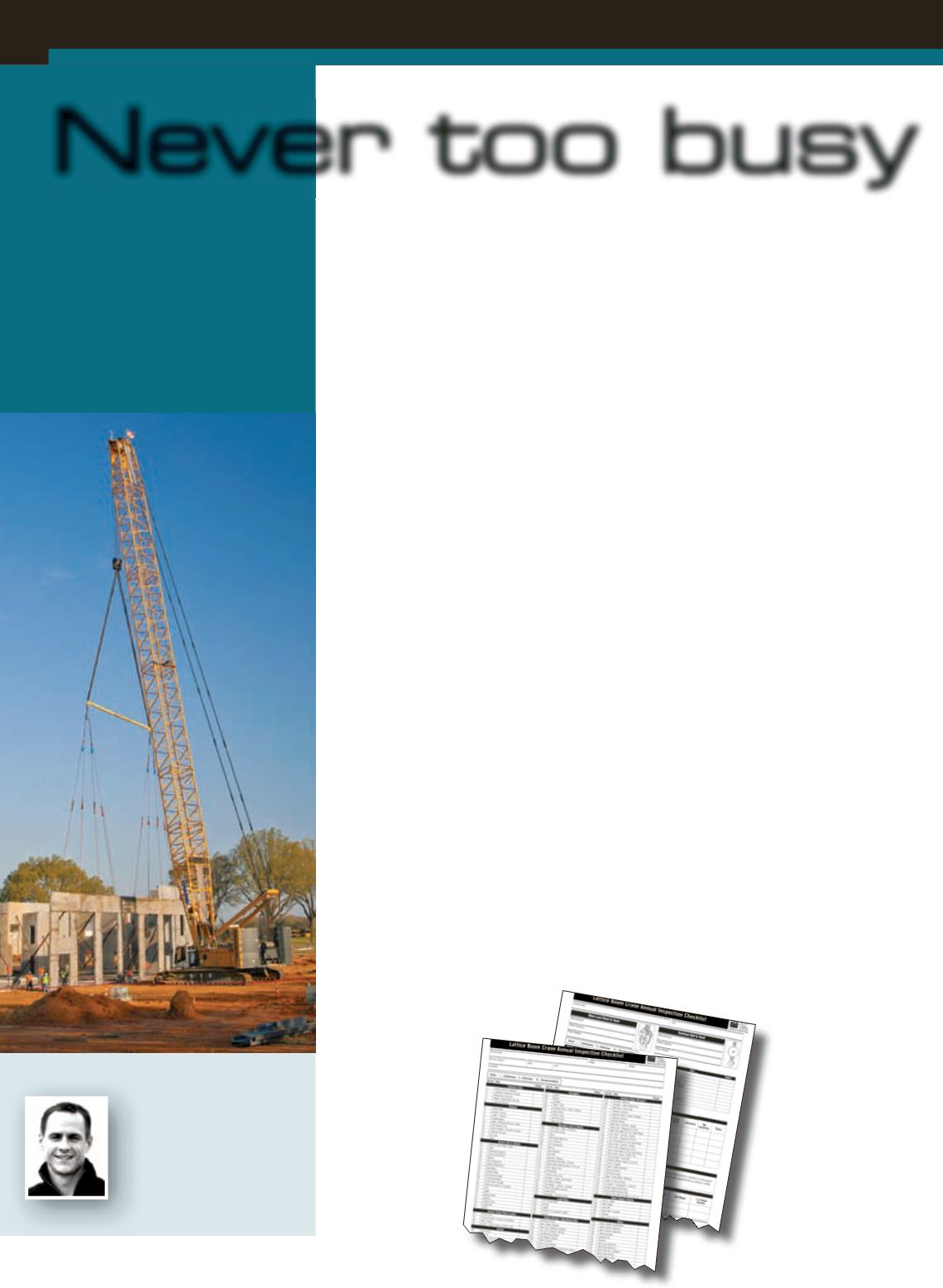
28
RIGGINGREVIEW
ACT
APRIL 2014
A checklist is away
to keep uniformity
by compensating for
potential limits of a
person’smemory or
attention to detail
andmake sure that
the information
you are asking
for on the list
is ultimately
gathered.
TimHillegonds
discusses
the need for checklists
when it comes to every
facet of crane operation.
Carriers andRiggingAssociation
(SC&RA) began an initiative todevelop a
number of comprehensive checklists for
members tousewhenperforming annual
inspections and accident investigations
for both latticeboom crawler and
telescopicboom cranes. The ideabehind
the checklists, aswell as everyother
SC&RAproduct or initiative, is toprovide
memberswith easy-to-use resources to
ensure saferworksites aswell as assist
companies in their efforts to remain
in compliancewith the latest industry
standards and regulations.
BethO’Quinn, SC&RAvicepresident,
believesmembers are servedwellwith the
checklists. “We are confident the forms
presented in eachguide canhelpour
membersprotect personnel, equipment
andproperty in thevicinityof the cranes,”
she said. “Theguidesminimize the risk
of an important taskbeingoverlooked
because someone forgot todo it or
presumed someone elsehad already
completed it.”
Oneof themost important benefits
of using a checklist is they take away
assumptions.
Staying on the right track
Bill Smith, executive vicepresident of risk
mitigation forNBIS, anAtlanta-based
hybridmanaginggeneral underwriting
(MGU) organization serving crane,
rigging, and specialized transportation
companies, sees value inusing checklists
to stayon the right track.
“A checklist is an aid tokeepyou
focused,”he said. “It isused as a reminder
and can assist you inuncovering all the
necessary step-by-stepdetails youneed
to evaluate inorder towork toward
identifying the root causeof the incident.”
Checklists canhelp small
companies that
donot have a full-
time safety staff.
WhenSC&RA’s
Crane&Rigging
GroupSafety
Education&Training
Committeedeveloped
theirAccident
InvestigationGuide, a
goalwas that smaller
companies coulduse it
as a roadmap.
Never too busy
THEAUTHOR
TimHillegonds
spent 10 years
in the heavy construction
insurance industry before
founding Thrive Creative
Services, a creative
copywriting agency dedicated
to helping businesses tell their stories.
T
he standard response to the
question, “How are you?”
used tobe “fine.”But now it’s
something else entirely. “Busy” iswhat
most peoplewill say as they look intoyour
eyes, exhausted, andpleadwithyounot to
give themonemore thing todo.
It’s a signof the times.We’re constantly
connected,whichmeans that people can
constantlydemandmore fromus– any
time, dayornight. Inone sense, all this
busyness is agood thing.After all, it
usuallymeanswe’re employed, and, to
somedegree, important. But the flipside
is that sometimeswe can forget things or
simplynot perform tasks to thebest of our
abilities. Forgetting to respond to an email
orpickupmilkon thewayhomemight
bemomentarily annoying, but it’s fixable,
and there aren’t usuallydetrimental
consequences.
But forgetting somethingwhen
assemblingordisassembling a crane,
when the crane’s boomwill eventuallybe
swinginghighover thehardhat-covered
heads ofmen andwomenwith family and
friends andpetswaiting for them at home,
in those situations, the stakes aremuch
higher. Injuries, propertydamage, death
– all very real possibilitieswhen someone
doesn’t take the time todo the job right.
Sohowdowedealwith it?Howdo
we remaindiligent about safety and the
important tasksweneed toperformwhen
it counts?
Perhaps this comes as a surprise, but in
theheavy construction industry,many
folks relyon checklists. Even in aworld
filledwithnew technology, sometimes the
old-fashioned taskofwriting something
down and checkingoff yourprogress
as yougo is thebestway tomake sure
nothing important getsmissed.
In2011, theSpecialized


